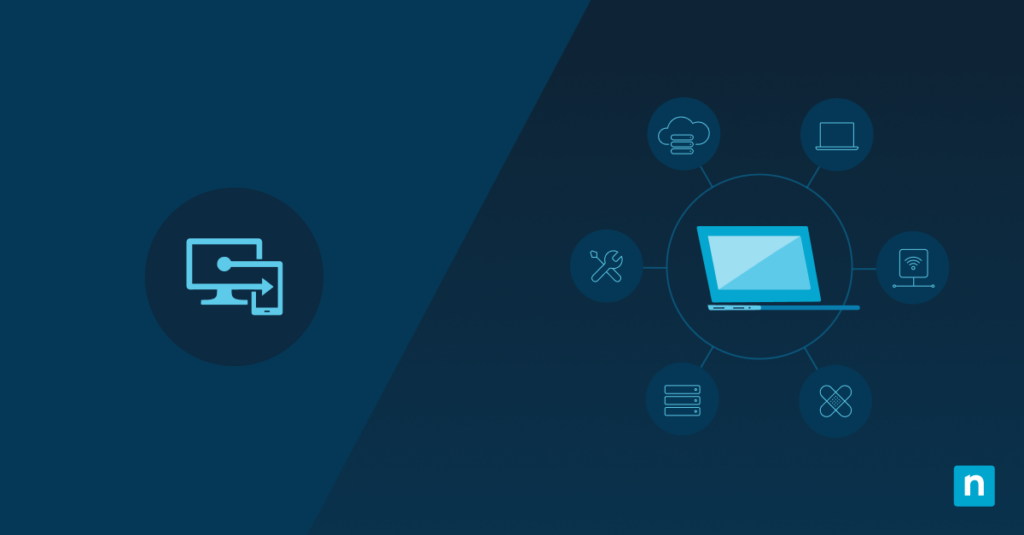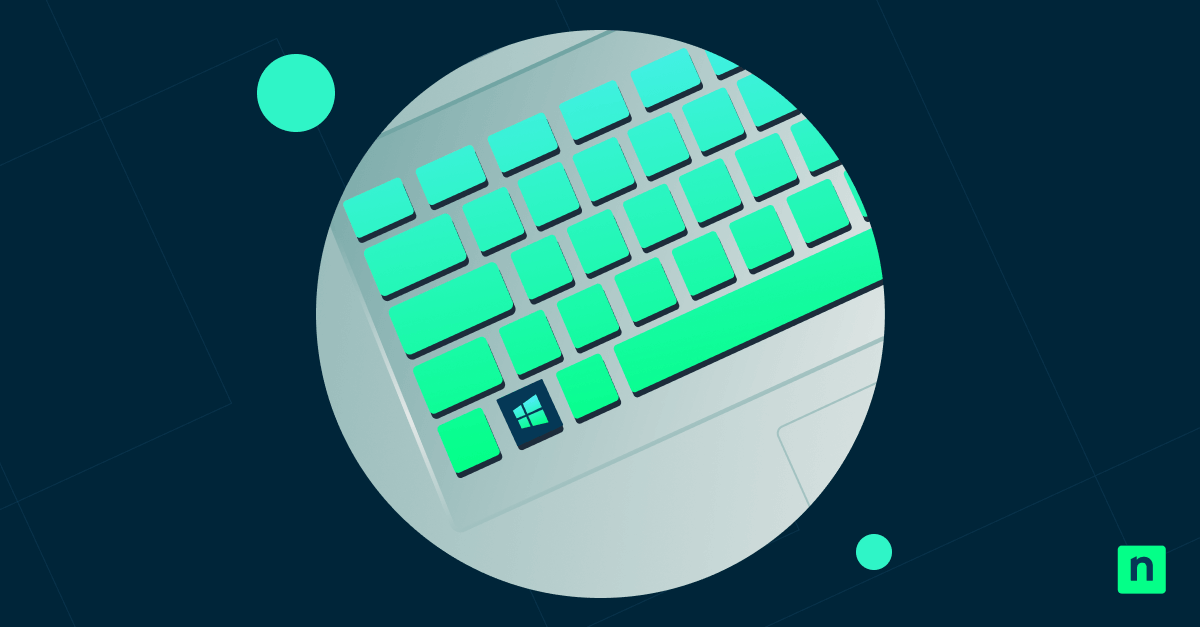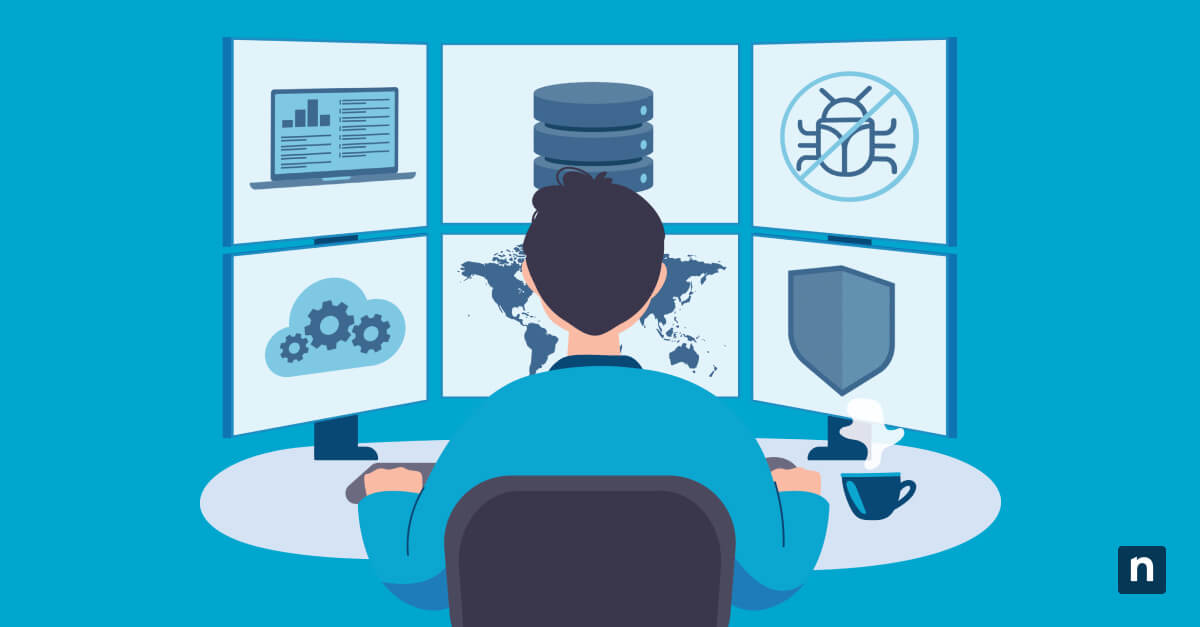Key Points
- Microsoft Intune is a cloud-based MDM tool that works best for Microsoft ecosystems and offers strong device onboarding. endpoint security, policy enforcement, and device configuration.
- Microsoft Intune is not an RMM or a true substitute, because it can be less flexible for multi-OS fleets or MSPs that require multi-tenancy.
- Use Intune when managing environments that heavily use Microsoft products such as Microsoft Entra.
- Use RMM tools when you need multi-tenant support, advanced automation, cross-platform coverage, or robust third-party application patching, or service desk tools.
- Alternatively, organizations can benefit from both. Integrating Intune with an RMM allows you to consolidate Intune’s policy management and an RMM’s full suite of tools for proactive management, automation, and service delivery.
It’s common for an MSP to question the value of Microsoft Intune managing their customers. A few common concerns tend to come up, including the pricing structure and the lack of multi-tenancy. It’s also something new that the MSP and their staff may need to learn.
With that said, is MS Intune bringing value to the MSP’s table? Is there some potential to be leveraged out of using Microsoft’s MDM as a managed service provider? In this article, we’ll talk about the product itself; and how MSPs integrate Intune into their stacks. We will also give the final verdict on Intune vs RMM.
NinjaOne MDM is a natural extension of its #1 endpoint management platform.
Download this essential guide to learn more.
What is Microsoft Intune?
Microsoft Intune is Microsoft’s proprietary SaaS solution. It is a cloud-based desktop and mobile device management (MDM) tool currently supporting macOS, iOS, Android, and Windows. Intune started out as an enterprise-level management tool but has become heavily used by SMBs in recent years.
Intune is a cloud-based solution that enables MDM and mobile application management — meaning it’s used to control how devices are utilized and enforce policies that allow IT professionals to keep devices and the network secure. The app actually focuses heavily on configurations and features that improve endpoint security.
Intune also helps users set up laptops and mobile devices by automatically deploying and enforcing device configurations across a large number of individual installs. In total, Intune works for device onboarding, configuration, and administration for highly homogeneous environments and device configurations.
Noteworthy Intune features:
- Autopilot deployments
- Device provisioning
- Automated RMM deployment
- Microsoft Defender deployment and management
- Policy enforcement on end-users and devices (standard lockdowns on accounts, expiries, screensaver lockouts)
- Microsoft Office configurations
Is Microsoft Intune an RMM?
Microsoft Intune focuses more on endpoint management. While it shares some overlap in functionality, such as the ability to manage devices remotely, RMM software offers more powerful features that allow IT teams to manage assets across multiple operating systems and manage multiple clients under a single account.
Can Microsoft Intune replace an RMM tool?
Microsoft Intune is not a proper replacement for an RMM tool, such as the one offered by NinjaOne. Intune lacks some key features that an RMM tool can provide such as remote control, native multi-tenancy, greater flexibility, and more support for non-Microsoft products.
When to use Intune vs RMM tools
Microsoft Intune and RMM have different applications, so it’s important to understand which tool to use. Here are some use case distinctions for Intune and RMM tools based on their core functionalities and your managed environment.
When to use Microsoft Intune
- When managing mobile endpoints: Microsoft Intune is built for managing mobile devices, offering MDM capabilities that enforce security and control over mobile phones, tablets, and other portable devices.
- When managing Windows-first environments: If you’re primarily managing Windows endpoints, it’ll be easy to deploy Intune since it’s deeply integrated with Microsoft 365, Azure Active Directory, and Windows Autopilot.
- When your primary focus is MDM and compliance: System administrators use Intune to enforce security configurations such as conditional access, password requirements, and encryption settings.
- When you’re an internal IT for an organization: Intune operates under a single-tenant model making it recommended for internal IT teams managing users and devices within a single organization.
When to use RMM tools
- When managing multiple clients or locations: Unlike Intune, RMM is built for multi-tenancy, which is ideal if you’re managing and monitoring multiple environments from a single console.
- When full visibility is needed: RMM allows system administrators to gain full visibility over their managed environments with real-time remote monitoring. This also involves receiving alerts for critical events, network health checks, and more.
- When you rely on these IT tasks: System administrators may depend on scripting, automation, and remote access to manage endpoints. In this case, a comprehensive RMM is the better choice to execute them.
- When you require support for cross-platform environments: RMM is best suited for diverse environments spanning from Windows, macOS, Linux, and even third-party apps and cloud services.
- When integrating service desk operations: A comprehensive RMM platform often integrates service desk functionalities such as billing, ticketing, and reporting. If you’re an MSP, an RMM can streamline operations and improve client support.
Why Microsoft Intune can’t replace RMM software
Limited remote access features
Intune offers a built-in remote assistance capability called Remote Help, which is available as an add-on or via the Intune Suite. With Remote Help, technicians can remotely access user devices for screen-sharing, full control, or unattended sessions on supported platforms. However, compared to an RMM, Intune still has key limitations. For example, the support technicians and the user must be in the same tenant, as full-cross-tenant remote support isn’t supported natively.
Single tenant
The subscription and all associated data are locked inside a single Microsoft Entra tenant — a major problem for managed service providers. There is currently no way for a service provider to monitor and manage multiple customers/subscriptions. If you’re trying to manage 100 clients, it means logging into 100 different Intune accounts (a common thread among MS Office services in general).
Third-party application patch management
With Intune, organizations can deploy third-party apps as Win32 packages in Windows 10 and use detection rules to identify needed updates. For Windows 11 devices, IT teams may need to purchase Enterprise App Catalog, an add-on for Intune Suite. However, the Win32 app and the Enterprise App Catalogue are not fully automated as they require administrator action. In contrast, RMM platforms feature larger catalogues for third-party software and greater control over deploying and automating patch management for non-Microsoft apps.
Limited monitoring tools
Intune’s monitoring capabilities can be limited compared to an RMM software that can offer more extensive monitoring tools that can provide immediate insights into system performance and security vulnerabilities.
Policy management
Intune’s policy management utilizes GPO (Group Policy Objects) for IT administrators to deploy policies to specific groups. While it allows for broad policy enforcement, fine-tuned control over specific configurations or patching is not as granular as an RMM solution. RMM software can enforce policies at scale but also enact specific scripts for individual endpoint devices.
Intune vs RMM: feature comparison
Below is a feature comparison of Microsoft Intune vs. a typical remote monitoring and management solution. Compare how Intune compares to a comprehensive RMM.
| Feature | Microsoft Intune | RMM Platform |
| Device Management (Windows, macOS, mobile) | ✅ | ✅ |
| Mobile Device Management (MDM) | ✅ | ⚠️ (Depends on the vendor) |
| Cloud-Native Management Console | ✅ | ✅ |
| Endpoint Security Configuration | ✅ | ✅ |
| Patch Management (OS & 3rd-party apps) | ⚠️ (Limited) | ✅ |
| Remote Access / Remote Control | ⚠️ (Limited via Quick Assist) | ✅ |
| IT Asset Management (hardware & software inventory) | ⚠️ (Basic) | ✅ |
| Automated Scripting / Task Automation | ⚠️ (PowerShell only) | ✅ |
| Third-Party App Deployment and Updates | ⚠️ (Limited) | ✅ |
| Managed Antivirus / EDR Integration | ⚠️ (Via Defender only) | ✅ |
| Remote Monitoring (device health, uptime) | ❌ | ✅ |
| Alerting and Notifications | ❌ | ✅ |
| Network Monitoring / SNMP Support | ❌ | ✅ |
| Multi-Tenant Support (for MSPs) | ❌ | ✅ |
| Billing and Ticketing Integration | ❌ | ✅ |
| Custom Policy Enforcement | ✅ | ✅ |
As you can refer to from the table, RMM may offer more functionalities than Intune when it comes to IT management and monitoring. However, Intune still has specific use cases that only it can address which were outlined in the “When to use Intune vs RMM tools” section above.
Microsoft Intune pros and cons
Microsoft Intune pros
What is the upside of using MS Intune? Let’s take a closer look.
Conditional access
Privilege access control is a critical part of IT security. Intune allows you to set accessibility rules that help keep people with lower levels of security from accidentally using unsafe devices to access important resources. Conditional access and privilege access control are also important components of certain compliance requirements.
Zero-touch deployment
Zero-touch deployment allows MSPs to ship ready-to-go devices to customers and save a significant amount of time when onboarding.
Mobile features
Intune brings mobile device features that supplement a lot of MDM features in RMM solutions. One useful example is the ability to easily and quickly separate personal and company data on devices. This feature alone can be invaluable in a number of different privacy and security scenarios.
Device flexibility
Intune can manage many different ownership and usage configurations. As an example, Android mobile devices can be managed under BYOD (Bring Your Own Device), CYOD (Choose Your Own Device), COBO (Corporately Owned, Business Only), and COPE (Corporately Owned, Personally Enabled) models.
Microsoft Intune cons
What challenges come with using Intune? Here are some common bits of MSP-specific feedback:
Difficult to use
Intune itself can be challenging to use, especially if the MSP hasn’t been formally trained on the use of the product. Users will require more time and training to be able to make full use of Intune compared to an RMM.
Finicky remote options
Intune’s Remote Help add-on can be challenging for IT professionals when the remote options don’t work for a particular endpoint. Troubleshooting issues with remote control can also prove to be a challenge.
Single tenant
The subscription and all associated data are locked inside a single tenant — a major problem for managed service providers. There is currently no way for a service provider to monitor and manage multiple customers/subscriptions. If you’re trying to manage 100 clients, it means logging into 100 different Intune accounts (a common thread among MS Office services in general).
Pricing
The price of a per-device license for Microsoft Intune has many users turning toward competing MDMs. It can be costly, especially for MSPs who need to convince smaller businesses that a noticeable increase in their pricing is worth the squeeze. It’s always a wise idea to research MDM pricing and how it aligns with your current IT budget.
Discover the 10 best MDM software tools based on real user reviews.
Is Microsoft Intune a good MDM?
While it’s becoming clear why Intune won’t serve as an RMM replacement, how does it hold up as an MDM system? That is its designed role, after all.
Probably the most obvious advantage offered by Microsoft Intune is its integration with existing services that you’re probably already selling to your clients.
The software offers sufficient configurations for effectively managing every aspect of devices in your client base. As you would expect, you can control who uses them and how, what apps are installed, how they’re used, and various security settings.
Configuration profiles populate these settings, with different profiles available for various devices and platforms. Profiles can be easily applied to devices individually or in a group with Microsoft Intune.
Additionally, Intune also features identity protection, Wi-Fi and VPN profiles, multi-user device management, and preference files for macOS. The Windows and macOS library contains settings that can be configured in one easy-to-access location.
There are quite a few MDMs to choose from, and you may be immediately intrigued by Microsoft’s proprietary offering, or that might be enough to dissuade you. All things considered, Intune does boast wide compatibility for mobile platforms, a cloud-based management console, and device enrollment that ranges from simple to in-depth.
What is Microsoft Intune Suite?
Microsoft Intune Suite is an advanced set of cloud-based tools for managing and securing devices, applications, and data. It is a series of add-ons for InTune that offer more options for MDM, remote access, and endpoint security. While InTune Suite offers powerful features, they have more specific applications that might not be as necessary for all businesses or MSPs.
In addition, since each capability offered by InTune Suite is a separate add-on, it can be more cost-effective to manage devices using comprehensive software that includes RMM and MDM.
RMM vs MDM – What’s a better Intune alternative?
If you’re looking for a Microsoft Intune alternative or a solution that can compliment its feature, you might be wondering whether MDM or RMM software would benefit your business more. Look around the internet and you’ll find plenty of questions surrounding the “MDM vs. RMM” topic. Finding the answer begins by understanding the differences between these tools and where their limitations come into play.
🥷 Manage, support, and secure all your mobile devices in one powerful solution.
Schedule your 14-day free trial today.
The primary difference between these software solutions is that MDM focuses on managing mobile devices while RMM solutions are intended to be comprehensive. RMM tools are so multi-use that many RMM solutions include their own MDM functionalities. Still, there are reasons why your business may benefit more from a specialized MDM solution than an extensive RMM.
That said, one of the major flaws of using Intune as an RMM replacement lies in its lack of multitenancy. Having to manage a unique account for each user is untenable for an MSP with any hope of growing and scaling. The single dashboard benefit of a solid RMM tool instantly knocks Intune out of the running.
How NinjaOne can work with Microsoft Intune
All-in-one RMMs like NinjaOne take it one step further, providing a single dashboard that helps MSPs collect better customer data and avoid wasted time spent toggling between software. By providing easy, complete visibility into their clients’ systems, all-in-one remote monitoring and management options are the best tool for the job.
NinjaOne is a cloud-native comprehensive RMM software with powerful MDM capabilities that consolidates visibility and control of all endpoint devices into a single pane of glass. RMM tools like NinjaOne can work together with Intune, giving you Microsoft-native device administration capabilities for mobile devices alongside the proactive device support and infrastructure management capabilities in NinjaOne.
If you’re already using Intune, you can seamlessly integrate with NinjaOne to deliver unified, intelligent endpoint management across every device type and operating system. NinjaOne centralizes full visibility and control of your devices managed by Intune alongside tools to ensure compliance and real-time monitoring. IT administrators can easily run scripts, push out crucial updates, and remediate issues on Intune-managed endpoints, while still enforcing policies and configuration control within Intune.
This deep integration enables organizations to pair Intune’s strengths in provisioning and policy governance with NinjaOne’s automation, alerting, and remediation capabilities. It also allows you to centralize management, reduce your tech stack, and enables your technicians to respond to issues faster.
Thousands of our MSP partners use NinjaOne and Intune together for a more unified endpoint management experience.
Conclusion: Intune MDM or RMM?
Intune is billed by Microsoft as a mobile device management (MDM) solution, but their definition is broad enough to include devices like laptops and desktops. Because Intune brings mobile device features that mimic a lot of MDM features that you’d find in RMM solutions, MSPs often wonder if they can replace their RMM with Intune.
As we’ve learned, Intune by itself isn’t quite enough. While it’s not a replacement for an RMM solution, Intune can work with next-gen RMM tools like NinjaOne. Get started quickly when you integrate NinjaOne RMM with Intune, with NinjaOne’s built-in automation for onboarding Intune-managed devices into NinjaOne.
On top of that, the NinjaOne RMM platform includes NinjaOne MDM, a robust solution that allows you to conveniently and efficiently manage all your endpoints from a single console to reduce complexity and cost. You can
Extend your Intune’s device management capabilities by integrating it with NinjaOne’s all-in-one tools for device management. If you’re ready, request a free quote, sign up for a 14-day free trial, or watch a demo.







